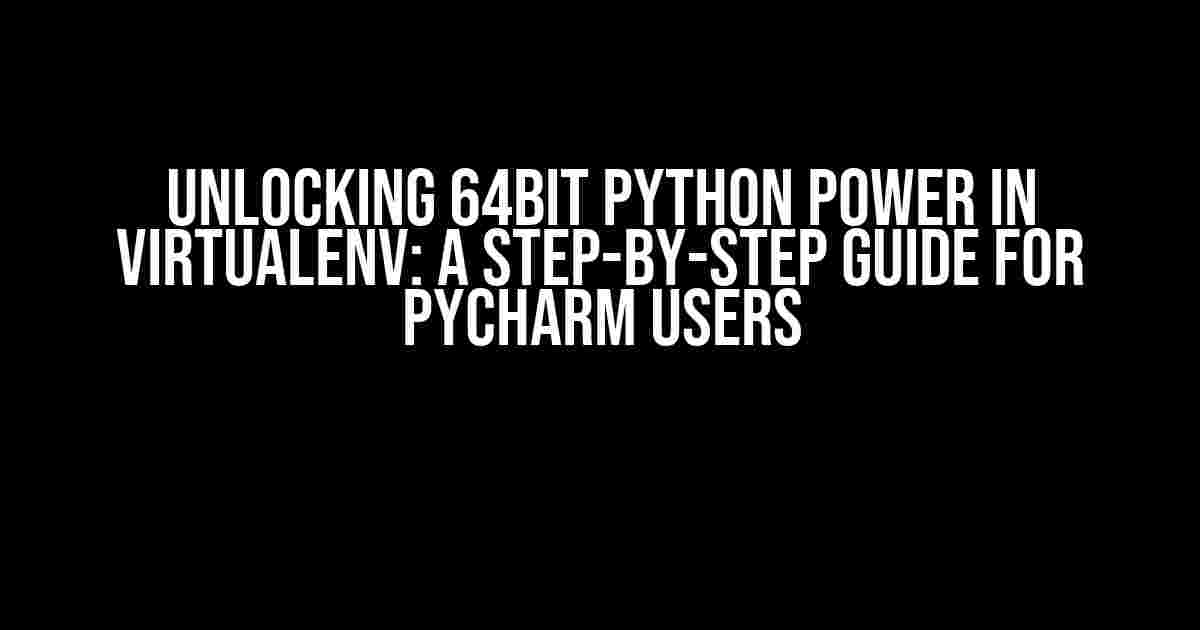Are you tired of being limited by the 32bit Python version installed on your machine? Do you want to harness the full potential of 64bit Python in your Virtualenv projects within PyCharm? Look no further! In this comprehensive guide, we’ll show you how to safely make a 64bit Python interpreter available to your Virtualenv, even when only a 32bit version is installed.
- Understanding the Problem: Why 32bit Python Limits Your Virtualenv
- Solution: Installing a 64bit Python Interpreter alongside 32bit Python
- Configuring PyCharm to Use the 64bit Python Interpreter
- Conclusion: Unlocking 64bit Python Power in Virtualenv
- Bonus: Tips and Tricks for Working with 64bit Python in Virtualenv
Understanding the Problem: Why 32bit Python Limits Your Virtualenv
When you create a Virtualenv in PyCharm, it uses the system’s default Python version to create the virtual environment. If you only have a 32bit Python version installed, your Virtualenv will also be limited to 32bit. This can be a problem, especially when working with large datasets or complex computations that require the extended memory address space of 64bit Python.
The Risks of Using a 32bit Python Interpreter in Virtualenv
- Memory constraints: 32bit Python can only address up to 4GB of RAM, leading to performance issues and crashes when dealing with large datasets.
- Incompatibility with 64bit dependencies: Some packages and libraries require 64bit Python to function correctly, making it difficult to work with dependencies that are only compatible with 64bit Python.
- Performance bottlenecks: 32bit Python can lead to slower execution times and increased latency, hindering your development workflow.
Solution: Installing a 64bit Python Interpreter alongside 32bit Python
To overcome these limitations, we’ll install a 64bit Python interpreter alongside the existing 32bit version. This will allow us to use the 64bit interpreter in our Virtualenv, ensuring we can harness its full potential.
Prerequisites: Ensuring You Have the Necessary Tools
Before we begin, make sure you have the following tools installed:
- pyenv (available for Windows, macOS, and Linux)
- PyCharm (ensure you have the latest version)
Step 1: Install 64bit Python using pyenv
pyenv install 3.9.5Replace `3.9.5` with the desired Python version. pyenv will install the 64bit version of Python.
Step 2: Verify the Installation
pyenv versionsThis command will list all installed Python versions, including the newly installed 64bit version.
Step 3: Create a New Virtualenv using the 64bit Python Interpreter
pyenv virtualenv 3.9.5 myenvReplace `myenv` with your desired Virtualenv name.
Step 4: Activate the New Virtualenv
pyenv activate myenvThis will activate the newly created Virtualenv, ensuring you’re using the 64bit Python interpreter.
Configuring PyCharm to Use the 64bit Python Interpreter
Now that we have a 64bit Python interpreter installed and a Virtualenv created, let’s configure PyCharm to use it.
Step 1: Open PyCharm and Create a New Project
Create a new project in PyCharm, selecting the correct project interpreter (the 64bit Python interpreter we installed earlier).
Step 2: Configure the Project Interpreter
In PyCharm, go to File > Settings > Project: [project_name] > Project Interpreter. Select the 64bit Python interpreter from the dropdown list.
| Setting | Value |
|---|---|
| Project Interpreter | pyenv/versions/3.9.5/bin/python |
Step 3: Verify the 64bit Python Interpreter in PyCharm
Open a new terminal in PyCharm and type:
python --versionThis should display the version of the 64bit Python interpreter.
Conclusion: Unlocking 64bit Python Power in Virtualenv
By following these steps, you’ve successfully made a 64bit Python interpreter available to your Virtualenv in PyCharm, even with only a 32bit Python version installed on your machine. This unlocks the full potential of 64bit Python, enabling you to tackle complex projects and computations with confidence.
Remember to update your project interpreter in PyCharm whenever you create a new project or Virtualenv. This ensures that you’re always using the correct 64bit Python interpreter, unlocking the full power of 64bit Python in your Virtualenv.
Bonus: Tips and Tricks for Working with 64bit Python in Virtualenv
- Use the
--system-site-packagesflag when creating a new Virtualenv to inherit packages from the global Python environment. - Regularly update your pyenv and Virtualenv environments to ensure you have the latest packages and security patches.
- Test your code on both 32bit and 64bit Python interpreters to ensure compatibility and identify potential issues.
With these tips and the steps outlined in this guide, you’re ready to unlock the full potential of 64bit Python in your Virtualenv projects. Happy coding!
Frequently Asked Question
Get ready to unlock the secrets of making a 64bit Python interpreter available to a Virtualenv in PyCharm, even when you only have a 32bit Python version installed on your machine!
Q1: Can I use a 32bit Python interpreter in PyCharm for my Virtualenv?
Unfortunately, no! If you want to take advantage of 64bit architecture, you’ll need a 64bit Python interpreter. PyCharm won’t allow you to use a 32bit interpreter for a 64bit Virtualenv. It’s time to think outside the box (or in this case, the bit limits)!
Q2: How do I download and install a 64bit Python interpreter on my machine?
Easy peasy! Head over to the official Python download page and grab the 64bit version of Python that matches your operating system. Follow the installation instructions, and you’ll be ready to roll in no time!
Q3: Can I use the same Python executable for both my system Python and Virtualenv?
Not recommended! Using the same executable for both system Python and Virtualenv can lead to package conflicts and other issues. Create a separate Python executable for your Virtualenv to keep things tidy and organized.
Q4: How do I configure PyCharm to use the new 64bit Python interpreter for my Virtualenv?
In PyCharm, go to File > Settings (or Preferences on Mac) > Project: [Your Project Name] > Project Interpreter. Click the gear icon next to the project interpreter dropdown, then select Show All.... Click the + button to add a new interpreter, and select the 64bit Python executable you installed earlier. Finally, apply the changes and restart PyCharm!
Q5: Are there any specific settings I need to configure in my Virtualenv to make it work with the 64bit Python interpreter?
Yeah! Make sure to configure your Virtualenv to use the correct Python executable. In your terminal, navigate to your project directory and run virtualenv -p /path/to/your/64bit/python/executable myenv (replace myenv with your Virtualenv name). This will create a new Virtualenv using the 64bit Python interpreter. Activate your Virtualenv using source myenv/bin/activate (on Linux/Mac) or myenv\Scripts\activate (on Windows). You’re now ready to go!



